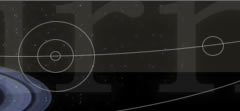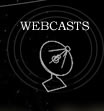|
|
A
MOON BY ANY OTHER NAME
In
July of 2004, the
Cassini
spacecraft went into orbit
around Saturn, becoming the first earth-born object to navigate
through the giant planet’s magnificent rings. During the
summer, the craft sent back hundreds of incredible images of the
shadowed rings, the planet’s wavy cloud tops, and, potentially,
four (at latest count) hitherto-unknown satellites. New moons!
Of course, new moons around the outer planets are continually
being discovered as spacecraft approach and instrumentation is
refined. There are now over 130 known planet-orbiting satellites
in our solar system: Jupiter leads with 61, and Saturn’s
in second place with 35. (Different sources give somewhat different
numbers; our source is NASA.)
Upon closer inspection, however, two of the new discoveries—known
as S/2004 S1 and S/2004 S2—don’t look much like moons,
as we know them, at all. They’re pretty small, for a start:
Each is less than five miles across, miniscule compared with our
moon’s 2,160-mile (3,476-kilometer) diameter. They’re
also not round but are instead irregular hunks of rock, bulging
and dented. You might be forgiven for wondering whether they even
deserve moon status. [Note: In 2005, these little moons received the names Methone and Pallene.]
But Saturn
does
have “proper” moons that
are large, round, and, well, moonlike: There’s Enceladus,
whose highly reflective surface may be covered in ice; Iapetus,
an enigma with one bright and one dark face; Mimas, with its huge
impact crater telling of a long-ago cataclysm. And, of course,
there’s Titan, giant among the planet’s companions.
Titan is, in fact, a primary goal of the Cassini-Huygens mission:
In December, the
Cassini
spacecraft will release the
Huygens
probe, which will descend through Titan’s
thick atmosphere and make the first exploration of that moon—a
world whose chemical signatures suggest the presence of molecules
that could eventually bring forth life. Next to Titan, S/2004
S1 and S/2004 S2 seem positively unmoonlike.
So does it make sense to think of these discoveries as moons at
all? How are moons different from the other chunks of rock—round
or lumpy, big or small—that populate the solar neighborhood?
You might think that size would be a key determinant, but the
astronomical community hasn’t established a minimum size
constraint on what makes a moon. But at least planets are always
bigger than moons, right? With a diameter of 3,200 miles (5,150
km), Titan is not only considerably bigger than our own moon,
it’s bigger than the planets Mercury (3,032 mi/4,880 km)
and Pluto (1,442 mi/2,320 km). (Of all the known moons in the
solar system, only Jupiter’s 3,270-mile [5,262-km] Ganymede
is larger than Titan.)
What about shape? It might seem compelling to reserve the title
“moon” for objects with rounded profiles, but again,
we have no system for determining when a body is too lumpy to
be called a moon. (Size and shape, incidentally, are fundamentally
related: The larger the object, the more mass it contains, and
the more gravity is exerted on the object’s exterior. Rocky
bodies over a certain size—around 62 miles in diameter—exert
so much gravity that large protrusions tend to crush the rocks
beneath them, gradually rounding the craggy profiles of younger
moons. Moons composed of different blends of materials become
rounded at greater or lesser sizes.)
Just like with terrestrial real estate, location may be the key
quality that makes a moon a moon. Take Mars’s moons: Phobos
(which means “fear” in Greek) is a mere 22 miles (35
km) in diameter, while Deimos (which means “panic”)
is only 12 miles (19 km) across. (Fear and Panic were demons and
sons of Ares, the God of War, in Greek mythology; in Roman mythology
Ares' equivalent is Mars.) Neither look at all moonlike: They’re
undistinguished boulders, commonly referred to as potato-shaped.
Yet because they orbit Mars and not the sun, it’s completely
reasonable to think of them as full-fledged moons.
But surely an object’s size plays
some
role? There
may indeed be some undefined size threshold below which an object
should be denied the appellative “moon.” After all,
as science writer Robert Roy Britt points out, we don’t
call the rocks that make up Saturn’s rings “moons,”
and
they
orbit a planet. Interestingly, scientist and
science writer Isaac Asimov once drew that line between Phobos
and Deimos: “One of Mars’s two moons is not a moon
at all in our sense of the word. I refer to Deimos, the outer
of the two, which is nothing but a mountain on the loose.”
If we were to go along with Asimov’s classification, “moons”
might have to have diameters exceeding 12 miles (19 km). But while
smaller satellites are sometimes called “inner moons”
or “moonlets,” nobody has rushed to support a 12-mile
(19-km) limit in moon classification.
So would we have to call a moon by another name if it orbited
a different parent? Consider comets, which certainly look and
behave differently than moons; the most spectacular ones we see
sport evanescent gas tails spreading over millions of miles of
night sky. Comets are chunks of rock and ice (“dirty snowballs”
in astronomer Fred Whipple’s colorful description) whose
surfaces warm up and release volatile gases as they approach the
sun. But a similar hunk of rock orbiting a planet might well be
called a moon.
Pluto is also thought to be little more than a block of rock and
ice, but its comparatively circular orbit around the sun makes
it a planet. If Pluto were somehow magically transported to the
belt between Mars and Jupiter, we might be happy to call it an
asteroid (or, more properly, a minor planet), as we do the other
denizens of that neighborhood. And if it circled the sun in a
highly elliptical orbit, close at one extreme and far away at
the other, we might think of Pluto as a comet. (In fact, some
voices have called for Pluto to be reclassified as an asteroid
or comet, given its diminutive size and far-flung orbit. However,
the International Astronomical Union [IAU], which is responsible
for naming space rocks, has resisted.) Similarly, asteroids captured
by planets become moons, and Uranus’s motion against the
background stars initially suggested it was a comet; it was reclassified
as a planet when its orbit around the sun was found to be more
circular than elliptical.
The problem, like so many others, is one of perspective: We have
lived so long with a particularly grand moon that others look
puny by comparison. In fact, for centuries, we only knew of one
body that orbited a planet—our own planetary companion.
“In the old days of astronomy, before Galileo, there was
just the Moon,” writes Britt. “Then scientists had
to accept the clear and visible evidence of four objects orbiting
Jupiter.” Our own satellite has set the terms for our use
of the word "moon"—and those terms actually turn
out to be rather unusual: “A planet the size of the Earth
has no business with such a huge moon,” Asimov notes. “The
Moon is 1/80 the mass of the Earth, and no other satellite in
this system even approaches a mass that large in comparison to
its primary.” (With the discovery of Pluto’s moon,
Charon, Asimov’s observation is no longer true.) Still,
after millennia with a huge, round, very moonlike moon, it’s
not hard to understand why we wonder whether something resembling
a flying spud should be called a moon at all.
|
|
|
|
|
|
WHAT'S
IN A NAME ?
Imagine this: The
Cassini-Huygens
spacecraft
is surprised by a spectacular, never-before-seen moon.
The spacecraft’s cameras capture hundreds of images
and send them back to excited scientists on earth, who
call it—what?
How do astronomical objects get their names? There’s
a set of established conventions—somewhat different
for natural satellites, planets, and surface features—administered
by the International Astronomical Union (IAU), an organization
formed in 1919. The IAU promotes and safeguards the
science of astronomy through international cooperation.
Its members are professional astronomers worldwide,
though it also maintains “friendly relations”
with organizations that include amateur astronomers.
Here’s how moons get named: When a moon is discovered
and confirmed, it’s given a provisional designation,
such as S/2004 S1, the name of one of the moons recently
discovered by
Cassini-Huygens
. The first S
stands for “satellite,” then the year discovered.
The second S stands for “Saturn,” and the
1 denotes that it’s the first Saturnian satellite
discovered this year. When its orbit becomes very well
determined and the position can be reliably predicted
far into the future, the moon receives a permanent number
from the IAU’s Minor Planet Center, and becomes
eligible for naming. The person who discovered the moon
is invited to suggest a name.
Celestial bodies don’t get just any old name,
though. Historically, most planets in our solar system,
and many of their moons plus smaller minor planets,
were given names from Greek and Roman mythology, but
that’s changing. In an effort to be more inclusive
of all earthly cultures and races, the IAU is now using
other mythologies in its list of appropriate naming
sources. For example, Sedna, a planetlike body discovered
at the fringes of solar system in 2003, was named for
an Inuit goddess of the ocean.
Once in a while, though, people are able to merge their
personal agendas with established conventions. Take,
for example, Jim Christy, an astronomer who discovered
a moon orbiting Pluto in the late 1970s. Once the moon
became eligible for naming, Christy wanted to call it
Char after his wife, Charlene. Fortunately for Christy,
he learned that in Greek mythology the ferryman who
piloted dead souls across the River Styx into Hades'
realm (Pluto's in roman mythology) was named Charon,
which was close enough to Charlene for him. The name
was eventually adopted, and honors both the mythological
tradition and Christy’s wife.
|
|
|
|
|
|
|
|











